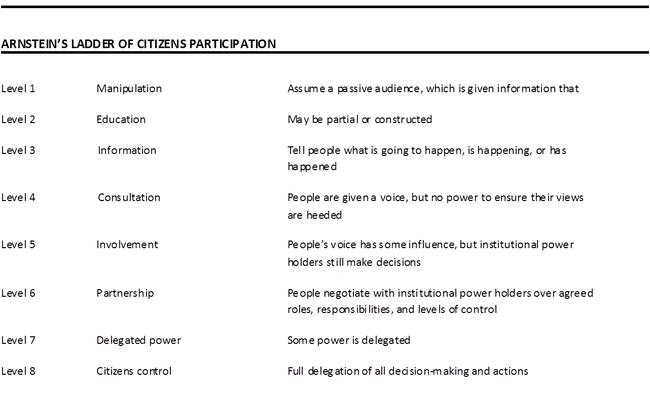Difference between revisions of "PEGASO participation methods"
(→References) |
(→What is Participation?) |
||
| Line 13: | Line 13: | ||
|} | |} | ||
| − | An effective participation process within environmental management brings several opportunities: it allows to obtain information that would not be available otherwise, it minimizes the uprising of conflicts and it leads to a greater quality and durability of decisions <ref name="Santos">Santos R., Antunes P., Baptista G., Mateus P., Madruga L. (2006). Stakeholder participation in the design of environmental policy mixes. In: Ecological Economics 60, 100–110 </ref><ref name="reed 2008">Reed M. S. (2008). Stakeholder participation for environmental management. A literature review. In: Biological Conservation 141, 2417–2431.</ref> | + | An effective participation process within environmental management brings several opportunities: it allows to obtain information that would not be available otherwise, it minimizes the uprising of conflicts and it leads to a greater quality and durability of decisions <ref name="Santos">Santos R., Antunes P., Baptista G., Mateus P., Madruga L. (2006). Stakeholder participation in the design of environmental policy mixes. In: Ecological Economics 60, 100–110 </ref><ref name="reed 2008">Reed M. S. (2008). Stakeholder participation for environmental management. A literature review. In: Biological Conservation 141, 2417–2431.</ref>. Furthermore, participation benefits include widening the representation of interests involved in decision-making, improving local “ownership” of strategies, having a positive impact on the legitimacy of policies and decision-making, ensuring that projects meet citizen’s needs <ref name="Fletcher 2003">Fletcher S. (2003). Stakeholder representation and the democratic basis of coastal partnerships in the UK. In: Marine Policy 27, 229–240</ref>. |
Notwithstanding, stakeholder participation can also pose challenges. Involving stakeholders can be costly, time-consuming, labour-intensive, confrontational, and can ultimately delay development and implementation of policies. Additionally, if improperly managed, stakeholders participation can create new conflicts or escalate existing ones <ref name="NOAA 2007">NOAA Costal service center (2007). Introduction to stakeholder participation. In: www.csc.noaa.gov</ref>. | Notwithstanding, stakeholder participation can also pose challenges. Involving stakeholders can be costly, time-consuming, labour-intensive, confrontational, and can ultimately delay development and implementation of policies. Additionally, if improperly managed, stakeholders participation can create new conflicts or escalate existing ones <ref name="NOAA 2007">NOAA Costal service center (2007). Introduction to stakeholder participation. In: www.csc.noaa.gov</ref>. | ||
Revision as of 14:35, 11 March 2013
What is Participation?
Public participation is widely recognised as a necessary tool to ensure a successful implementation of environmental policies: the Conference on Environment and Development (Earth Summit) in Rio de Janeiro in 1992, Principle 10 (UNCED, 1992a) and Agenda 21 (UNCED, 1992b) both called for increased public participation in environmental decision-making and led to the adoption in Europe of the Aarhus Convention (UN ECE, 1998). Furthermore participation has become a fundamental pillar of environmental processes as described in the Water Framework Directive (2000/60/EC), the 2002 EU Recommendation on ICZM (2002/413/EC) and the Mediterranean Protocol on ICZM (UNEP-MAP, 2008).
Participation can be defined as a process where individuals, groups and organisations choose to take an active role in making decisions that affect them [1]. Since the Conference on Environment and Development of 1992, public participation has been recognised as a necessary element of all environmental procedures like environmental assessment, local Agenda 21, and ICZM.
The most famous categorization of participation is the so called “Ladder of participation” (Arnstein, 1969 [2]). The categorization shows the different ways in which the organisation responsible for activity (e.g. an authority) can involve participants, in this case citizens.

|
| Fig. 1 : Arnstein’s ladder of citizen participation |
An effective participation process within environmental management brings several opportunities: it allows to obtain information that would not be available otherwise, it minimizes the uprising of conflicts and it leads to a greater quality and durability of decisions [3][4]. Furthermore, participation benefits include widening the representation of interests involved in decision-making, improving local “ownership” of strategies, having a positive impact on the legitimacy of policies and decision-making, ensuring that projects meet citizen’s needs [5].
Notwithstanding, stakeholder participation can also pose challenges. Involving stakeholders can be costly, time-consuming, labour-intensive, confrontational, and can ultimately delay development and implementation of policies. Additionally, if improperly managed, stakeholders participation can create new conflicts or escalate existing ones [6].
References
- ↑ Reed M. S., Graves A., Dandy N., Posthumus H., Hubacek K., Morris J., Prell C., Quinn C. H., Stringen L. C. (2009). Who’s in and why? A typology of stakeholder analysis methods for natural resource management. In: Journal of Environmental Management 90, 1933–1949
- ↑ Arnstein S. R. (1969). A Ladder of Citizens Participation Journal of the American Institute of Planners 35:216-224)
- ↑ Santos R., Antunes P., Baptista G., Mateus P., Madruga L. (2006). Stakeholder participation in the design of environmental policy mixes. In: Ecological Economics 60, 100–110
- ↑ Reed M. S. (2008). Stakeholder participation for environmental management. A literature review. In: Biological Conservation 141, 2417–2431.
- ↑ Fletcher S. (2003). Stakeholder representation and the democratic basis of coastal partnerships in the UK. In: Marine Policy 27, 229–240
- ↑ NOAA Costal service center (2007). Introduction to stakeholder participation. In: www.csc.noaa.gov